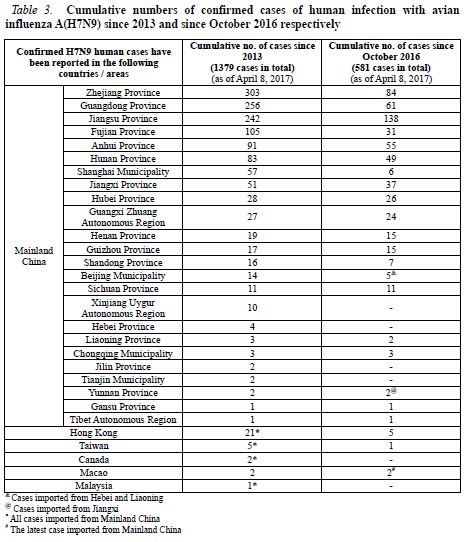#12,376
Hong Kong's Centre For Health Protection has released their weekly avian influenza report, and as has become common the past few months, it is essentially a recap of the announcement made the end of the previous week by China's NHFPC (see Friday's HK CHP Notified Of 14 New H7N9 Cases From The Mainland) with one additional case from Gansu Province reported on the 8th.
While the number of H7N9 cases reported last week continues to decline (n=15), the big news is the detection of human cases in two - previously unaffected - provinces; Gansu and Tibet Autonomous Region (see Saturday's Tibet Autonomous Region Statement On Their 1st H7N9 Case).
First the summary from today's report, then I'll return with a bit more.
Avian Influenza Report
Avian Influenza Report is a weekly report produced by the Respiratory Disease Office, Centre for Health Protection of the Department of Health. This report highlights global avian influenza activity in humans and birds.
VOLUME 13, NUMBER 14
Reporting period: April 2, 2017 – April 8, 2017 (Week 14)
(Published on April 11, 2017)
Summary
- Since the previous issue of Avian Influenza Report (AIR), there were 15 new human cases of avian influenza A(H7N9) reported by Mainland China health authorities in Beijing (3 cases), Hunan (2 cases), Jiangsu (2 cases), Chongqing (1 case), Fujian (1 case), Gansu (1 case), Guizhou (1 case), Henan (1 case), Shandong (1 case), Tibet (1 case) and Zhejiang (1 case). Since March 2013 (as of April 8, 2017), there were a total of 1379 human cases of avian influenza A(H7N9) reported globally. Since October 2016 (as of April 8, 2017), 573 cases have been recorded in Mainland China.
- Since the previous issue of AIR, there were no new human cases of avian influenza A(H5N6). Since 2014 (as of April 8, 2017), 16 human cases of avian influenza A(H5N6) were reported globally and all occurred in Mainland China. The latest case was reported on December 1, 2016.
- Since the previous issue of AIR, there were no new human cases of avian influenza A(H5N1). From 2011 to 2016, 10 to 145 confirmed human cases of avian influenza A(H5N1) were reported to the World Health Organization (WHO) annually (according to onset date). In 2017, there have been so far two cases in Egypt.*
H7N9 first appeared in China in the spring of 2013, and seemingly peaked the following winter when 320 human cases were reported during its second wave. Subsequent waves diminished in size, with the 4th wave reportedly infecting only 118 people.
When this 5th H7N9 epidemic season began last October, the world had seen a total 798 H7N9 cases (starting in 2013), and 19 Chinese Provinces had reported (at least one) human infection - with Zhejiang (n=219), Guangdong (n=195), and Jiangsu (n=104) leading the pack.
By early February it was apparent that this 5th wave was different.
Case counts by week 6 had already exceeded the total for the second wave (n=360), and a couple of weeks later we were to learn from the Guangdong CDC that two H7N9 HPAI `Variants' had been isolated from human cases.
A new LPAI lineage (Yangtze River Delta) had also appeared (see MMWR:Increase in Human Infections with Avian Influenza A(H7N9) In China's 5th Wave), and a recent analysis of cases (see Eurosurveillance: Preliminary Epidemiology & Analysis Of Jiangsu's 5th H7N9 Wave) suggests this new lineage may be more virulent, and possibly more `heat tolerant' and able to spread during warmer months.
In mid-February, Beijing Ordered Closure Of Live Bird Markets To Control H7N9, and while the number of new cases has dropped significantly over the past 8 weeks, the interruption of disease transmission hasn't been nearly as dramatic as we've seen from previous closures.
Since that order was issued, at least 120 new cases have been reported, exceeding the total number of cases reported during the entire 4th wave.
Additionally, the number of Provinces in China reporting H7N9 human infections has jumped from 19 at the beginning of this 5th epidemic - to 24 today - with Gansu and Tibet added just this week.
How the introduction of a new HPAI version of H7N9 will impact its spread is still very much an open question.
Even if warmer weather, and forced market closures, continue to drive down the weekly numbers down - this 5th H7N9 wave is already one for the record books. We are only about 50 cases shy of doubling the case count for the 2nd (and until now, the worst) wave.
But more importantly is the growing diversity of the H7N9 virus, now available in two lineages, and in an LPAI and an HPAI version.While sustained or efficient transmission of the virus has not been reported, the continued evolution - and recent perceived aggressiveness - of the H7N9 virus has everyone's attention.

